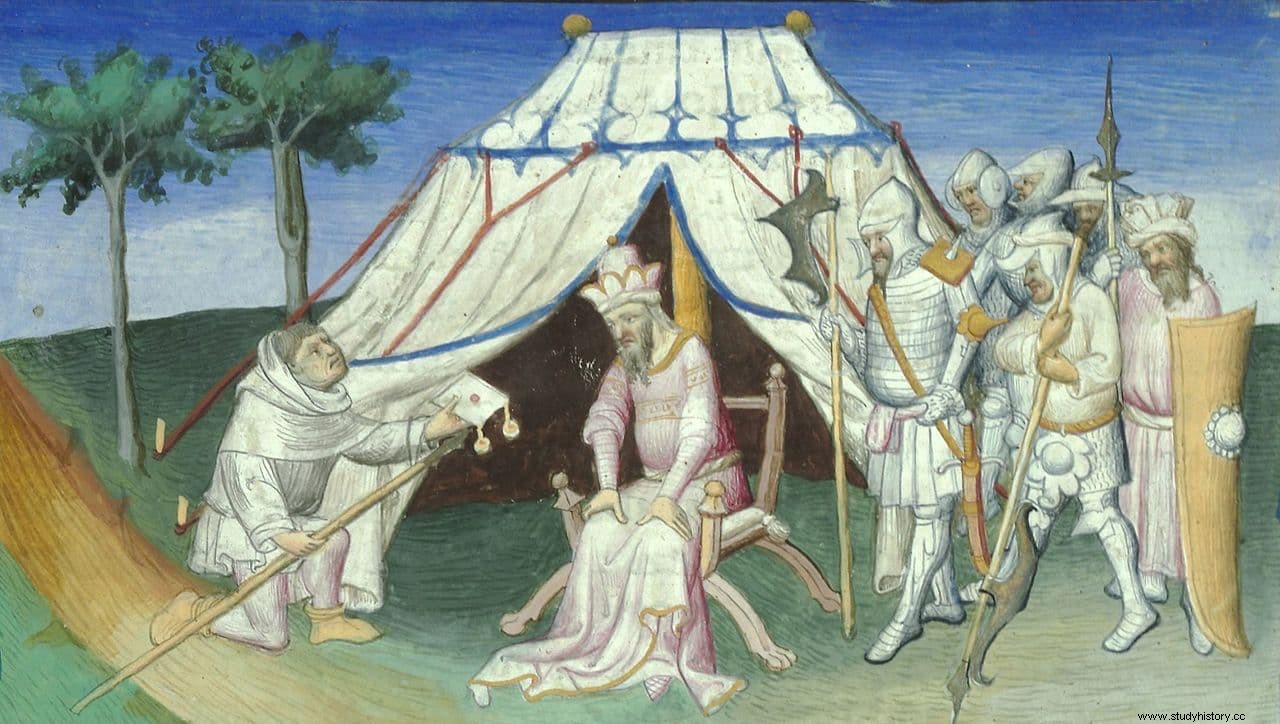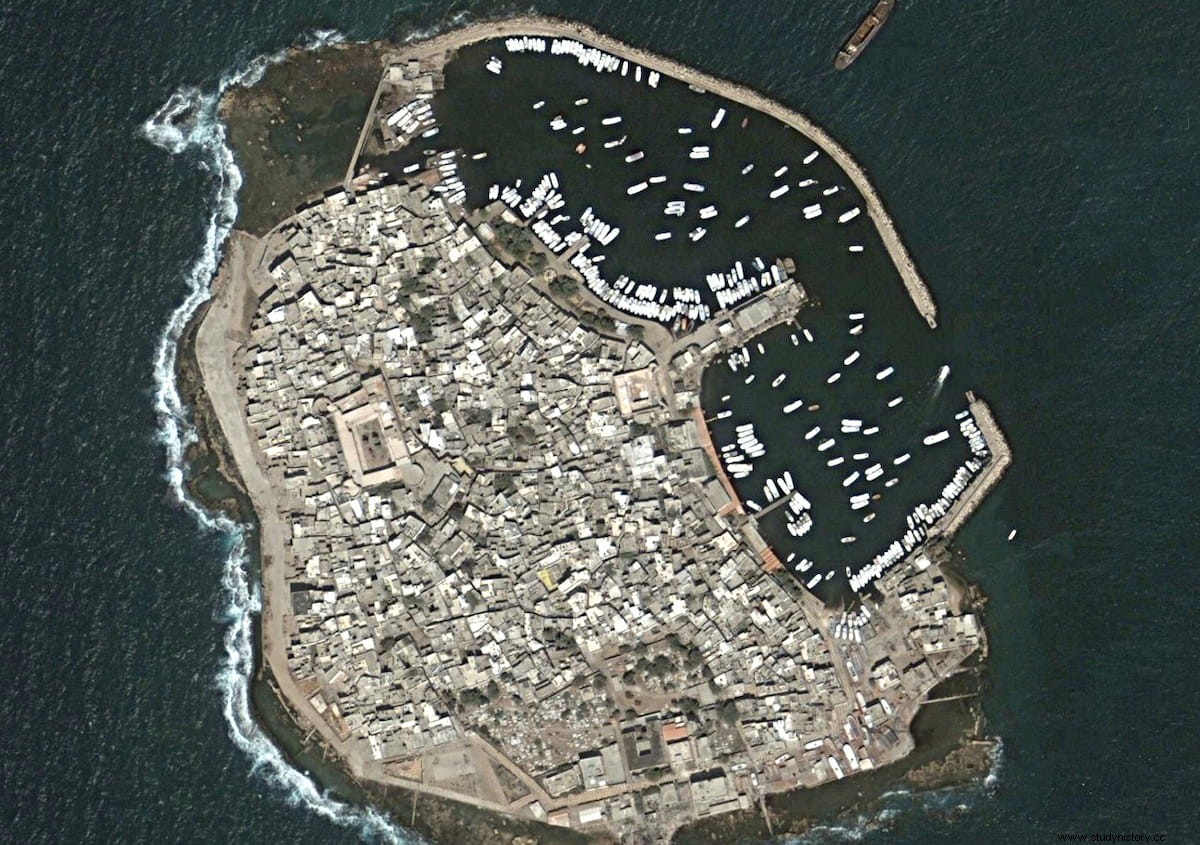The Christian world undertook against the Muslim nine crusades or religious wars in dispute for control of the Holy Land. The ninth and last, which some consider only an extension of the previous one, took place between 1271 and 1272. It was led by Prince Edward I of England, who took over from King Louis IX of France, who died during the eighth. Once again it ended in failure and this time definitively. The Christians had to leave the region and the last episode was the fall of Ruad, the last stronghold, in 1302.
Ruad (or Arwad) is an island located about three kilometers from Tartus, the ancient Tortosa, on the Syrian coast. If today it houses just over four thousand inhabitants constituting a quiet fishing village, its history collected a wide range of cultures and civilizations that included the Egyptian, the Phoenician and the Persian before being Hellenized at the hands of the Seleucids and then passing to Roman rule. .
In the Middle Ages, due to its characteristics, it became a magnificent bridgehead for the Crusaders, after the fall of Acre in 1291 meant their renunciation of the Kingdom of Jerusalem and their presence in the Levant.

That island was so good for that that, in effect, at the end of the year 1300 it was the place chosen to restart the conquest. It also had the symbolic fact that the port of Tortosa had been the point through which the crusaders had left the region to install the kingdom in Cyprus, something that the masters of the great orders of chivalry, the Temple and that of the Hospital, because having been unable to defend the last strongholds (those of Sarvandikar and Roche-Guillaume, in Antioch), they were the main promoters of the new campaign.
The plan was bold. It consisted of opening a double front against the Mamluks, one from the Syrian coast and the other from the interior. The latter would be in charge of Ghazan, the Mongol khan of the Ilkhanate (the khanate corresponding to Persia plus present-day Azerbaijan and central-eastern Turkey), who was a Muslim but a convert from Buddhism, and the previous year had carried out a raid that allowed him to conquer Damascus; then he had to leave that city but convinced that he could retake it if the Christians attacked Syria from the sea. Consequently, he sent an embassy to Cyprus to propose to Henry II of Jerusalem and Pope Boniface VIII an alliance.

Enrique, assertive, sent the khan two galleys captained by Guy de Ibelin and Jean de Giblet as a sign of friendship to collaborate in the siege of the city of Botrun and, after seizing it, rebuild the fortress of Nefin, both in what today it is lebanon. It was the fall of 1299, and before the year was out Ghazan crushed the Mamluks at the battle of Wadi al-Khazandar, for which he had a small supply of Templar and Hospitaller soldiers. The Mongols had to leave due to the civil war that their empire was suffering but they promised to return in a year, summoning the European kings to have everything ready by then and start a tenth crusade together.
And as he had left in situ a small army that devastated Palestine, the Christian monarchs, in effect, rubbed their hands before that powerful ally. Unfortunately for them, the Mamluks counterattacked from Egypt and the Mongols, outnumbered, chose to withdraw.
Perhaps that should have set off alarm bells, but since his election as grand master of the Order of the Temple in 1292, Jacques de Molay was determined to organize a new crusade to cleanse the tarnished name of his own; something in which he agreed with his colleague -and rival- of the Order of the Knights of the Hospital, Guillaume de Villaret.

It was not easy because although the monarch of Jerusalem was favorable to the idea of a crusade -after all, its success would give him back his true kingdom-, a shadow of discord had arisen between him and the Templars:the support that Guillaume de Beaujeu, former Grand Master, had lent another claimant to the throne. In 1285, Henry had succeeded his brother John I, who died of poisoning, and Charles of Anjou, King of Sicily, accused him of being involved. Charles, of course, had personal interests, since Mary of Antioch had sold him the rights to Jerusalem. And it turned out that Guillermo was a relative of Carlos.

In the end, Henry was able to retain ownership of Jerusalem, but he was left with a trace of bitterness against the Temple that the pope considered necessary to placate in order to save the idea of the crusade. That is why he ordered Jacques de Molay to reestablish proper relations with Cyprus. The fulfillment of the mandate allowed the Templar Grand Master and the Hospitaller to obtain the collaboration of Henry II to charter a squadron of sixteen galleys in which troops from the three great religious orders (the other was the Teutonic) were embarked, in addition to a contingent Cypriot and even the Ghazan ambassador, the merchant Isol el Pisano .
The fleet attacked several important ports such as Alexandria, Rosetta, Acre, Tortosa and Maraclea, the penultimate being considered the most suitable for landing and penetrating inland. In November 1300, under the joint command of Molay and Prince Amalric of Tire (also known as Amalric of Lusignan, brother of the king), they began the campaign proper, first seizing the aforementioned island of Ruad. There were about six hundred men, one hundred and a half of them Knights Templar who soon made the leap to Tortosa, taking it in less than a month.
The fall of the city was dramatic for its inhabitants, as they suffered looting and pillaging by the Crusaders. However, they did not plan to stay long; Trusting that the Mongols would be doing their part, in Aleppo they contacted General Kutlushah, who was advancing through Antioch, to be greatly disappointed:he barely came with sixty thousand troops, many recruited on the fly in Armenia, because Ghazan had run into a harsh winter against him that had made a good part of his team sick, forcing him to delay his participation.

With such a meager force, he completely changed the landscape. Kutlushah sent twenty thousand horsemen to the Jordan Valley to protect the Mongol governor of Damascus, laying waste to everything they found along the way; but once that raid was over he returned to his country. The Christians had to end the adventure and return to Cyprus, although they left a garrison at Ruad. While Jacques de Molay began an itinerant route through the European courts in search of help, in November 1301 the Pope granted possession of the island to the order of the Temple, which sent reinforcements and dedicated itself to intense polyorcetic work.
The grand master turned to all the great kings:Edward I of England, James II of Aragon, Philip IV the Handsome of France… None wanted to compromise because at the moment they had their own business to attend to, as the Aragonese focused their attention on gaining control of Sicily while the others warred with each other over Aquitaine. Therefore, the idea of a tenth crusade was delayed and, meanwhile, the Mamluks prepared for the reconquest of Ruad, which in enemy hands constituted a true sword of Damocles that they could not allow.

And so a fleet of sixteen ships sailed from Egypt in 1302 to the island, laying siege to it. The Mamluks managed to land at two points and set up a camp from which to launch attacks, while the ships were in charge of blocking the passage to any possible supply or help. Since the Ruad is very small and lacks drinking water, the need soon began to take its toll on the defenders, who were commanded by Bartholomew de Quincy. They hoped that help would arrive from Cyprus and, indeed, a fleet sailed from Famagusta to the rescue.
There is no data on how many attackers gathered at the siege of Ruad, but the Christians numbered one hundred and twenty knights (including Catalan Templars such as Hugo de Ampurias and Dalmau de Rocaberti), five hundred Cypriot and Syrian archers, apart from some four hundred Turkopoles; a considerable number that was equivalent to approximately half of the Templar force that was in Jerusalem in the twelfth century. Now, it is of little use to be many and have good defenses if there is no food or drink. There was no choice but to capitulate.
The negotiations were carried out by the knight Hugo de Dampierre, who agreed to abandon the position on September 26 in exchange for free passage into Christian territory. However, the Mamluks did not respect the pact and as soon as the defenders came out of their walls they fell on them. it was a massacre in which only a few dozen Templars survived and were taken to Cairo for ransom; This one never came and they all died in captivity over the years, refusing to accept the Islamic faith that would have brought them freedom.

The Cypriot fleet destroyed the city of Damour in retaliation, and in the spring of 1303 Ghazan finally appeared with eighty thousand men and an auxiliary Armenian army. But by then there was no possibility of a joint attack and in April his generals Kutlushah and Mulay were defeated at Marj al-Saftar, near Damascus, in a battle that Islamic historiography considers momentous.
The khan died the following year and although his brother and successor, Öljaitü, would try to renew the alliance by contacting the new pope, Clement V, he was busy calling Jacques de Molay to his presence to clarify the accusations of paganism and heresy that there were about him. the order. The trial against the Templars began and, with it, the chimera of another crusade ended.
